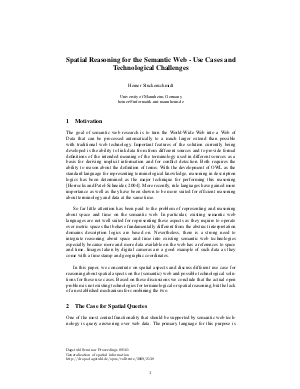Spatial Reasoning for the Semantic Web - Use Cases and Technological Challenges
Author Heiner Stuckenschmidt
-
Part of:
Volume:
Dagstuhl Seminar Proceedings, Volume 9161
Part of: Series: Dagstuhl Seminar Proceedings (DagSemProc) - License:
 Creative Commons Attribution 4.0 International license
Creative Commons Attribution 4.0 International license
- Publication Date: 2009-09-21
File

PDF
DagSemProc.09161.6.pdf
- Filesize: 118 kB
- 7 pages
Document Identifiers
Subject Classification
Keywords
- Semantic Web
- Spatial reasoning
Metrics
- Access Statistics
-
Total Accesses (updated on a weekly basis)
0Document
0Metadata
Abstract
The goal of semantic web research is to turn the World-Wide Web into a Web of Data that can be processed automatically to a much larger extend than possible with traditional web technology. Important features of the solution currently being developed is the ability to link data from from different sources and to provide formal definitions of the intended meaning of the terminology used in different sources as a basis for deriving implicit information and for conflict detection. Both requires the ability to reason about the definition of terms. With the development of OWL as the standard language for representing terminological knowledge, reasoning in description logics has been determined as the major technique for performing this reasoning cite{OWLreasoning}. More recently, rule languages have gained more importance as well as they have been shown to be more suited for efficient reasoning about terminology and data at the same time.
So far little attention has been paid to the problem of representing and reasoning about space and time on the semantic web. In particular, existing semantic web languages are not well suited for representing these aspects as they require to operate over metric spaces that behave fundamentally different from the abstract interpretation domains description logics are based on. Nevertheless, there is a strong need to integrate reasoning about space and time into existing semantic web technologies especially because more and more data available on the web has a references to space and time. Images taken by digital cameras are a good example of such data as they come with a time stamp and geographic coordinates.
In this paper, we concentrate on spatial aspects and discuss different use case for reasoning about spatial aspects on the (semantic) web and possible technological solutions for these use cases. Based on these discussions we conclude that the actual open problem is not existing technologies for terminological or spatial reasoning, but the lack of an established mechanism for combining the two.
Cite As Get BibTex
Heiner Stuckenschmidt. Spatial Reasoning for the Semantic Web - Use Cases and Technological Challenges. In Generalization of spatial information. Dagstuhl Seminar Proceedings, Volume 9161, pp. 1-7, Schloss Dagstuhl – Leibniz-Zentrum für Informatik (2009)
https://doi.org/10.4230/DagSemProc.09161.6
BibTex
@InProceedings{stuckenschmidt:DagSemProc.09161.6,
author = {Stuckenschmidt, Heiner},
title = {{Spatial Reasoning for the Semantic Web - Use Cases and Technological Challenges}},
booktitle = {Generalization of spatial information},
pages = {1--7},
series = {Dagstuhl Seminar Proceedings (DagSemProc)},
ISSN = {1862-4405},
year = {2009},
volume = {9161},
editor = {S\'{e}bastien Musti\`{e}re and Monika Sester and Frank van Harmelen and Peter van Oosterom},
publisher = {Schloss Dagstuhl -- Leibniz-Zentrum f{\"u}r Informatik},
address = {Dagstuhl, Germany},
URL = {https://drops.dagstuhl.de/entities/document/10.4230/DagSemProc.09161.6},
URN = {urn:nbn:de:0030-drops-21386},
doi = {10.4230/DagSemProc.09161.6},
annote = {Keywords: Semantic Web, Spatial reasoning}
}
